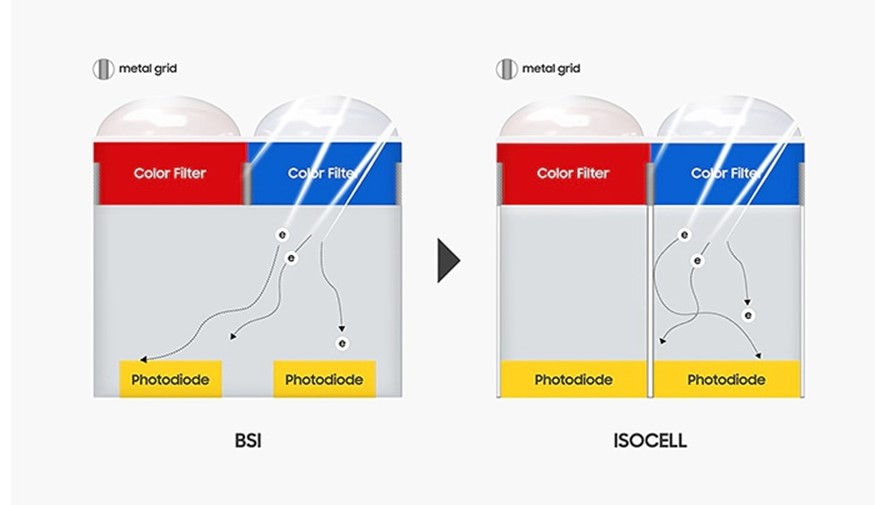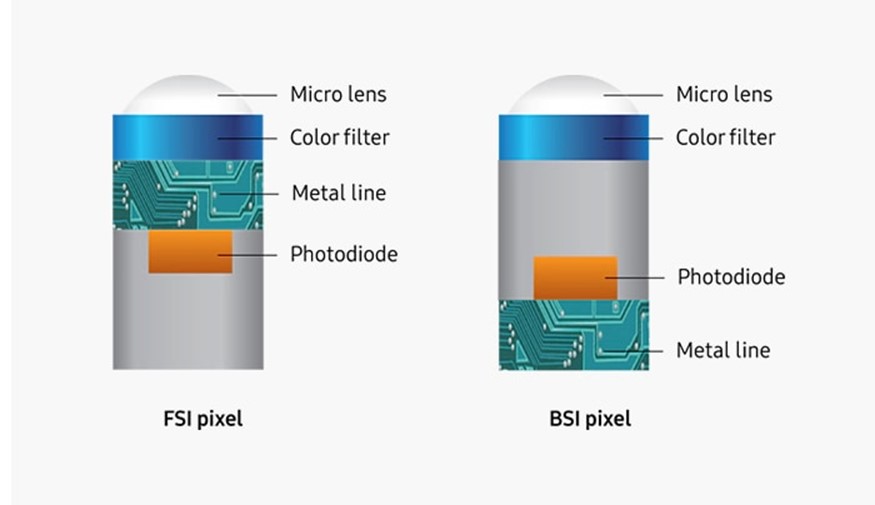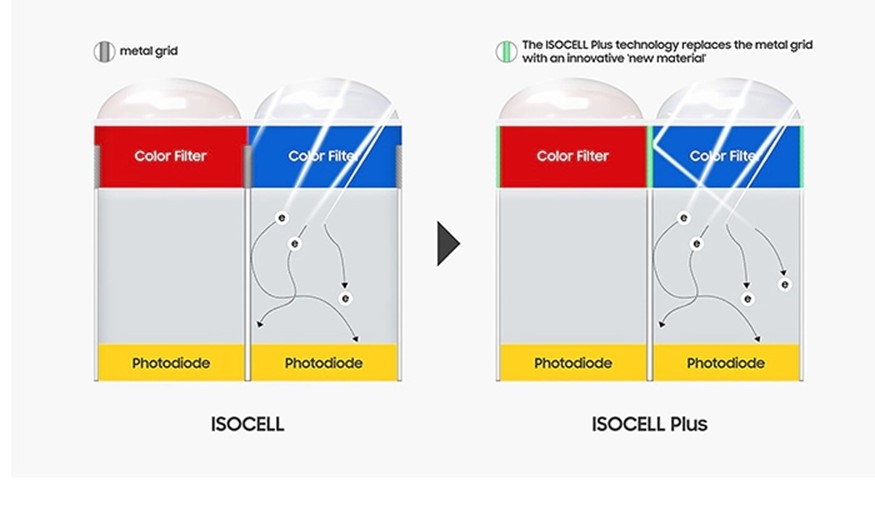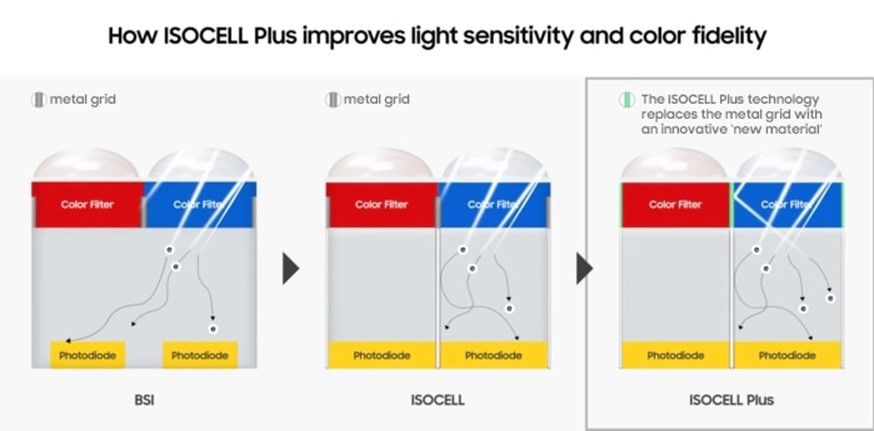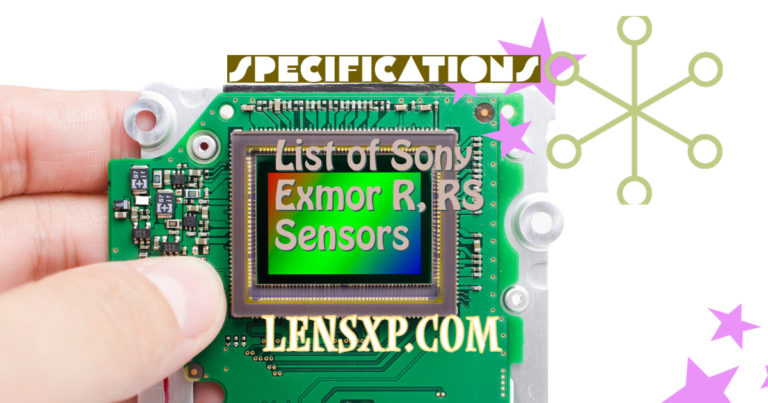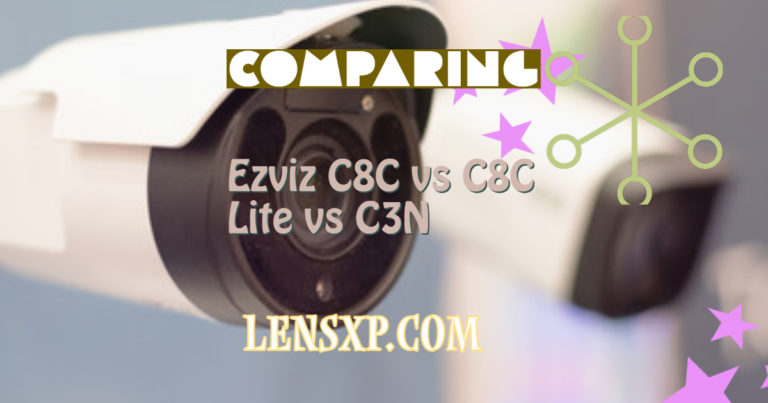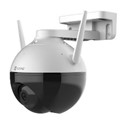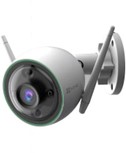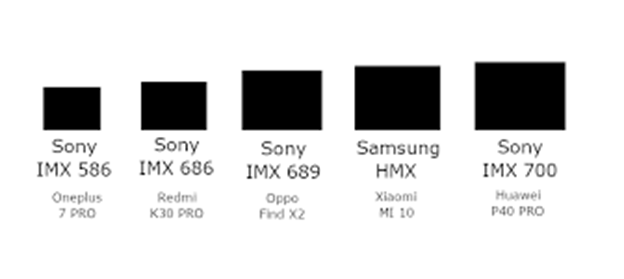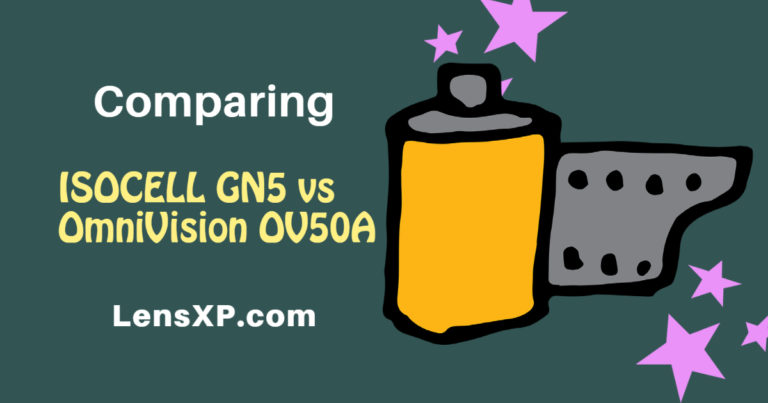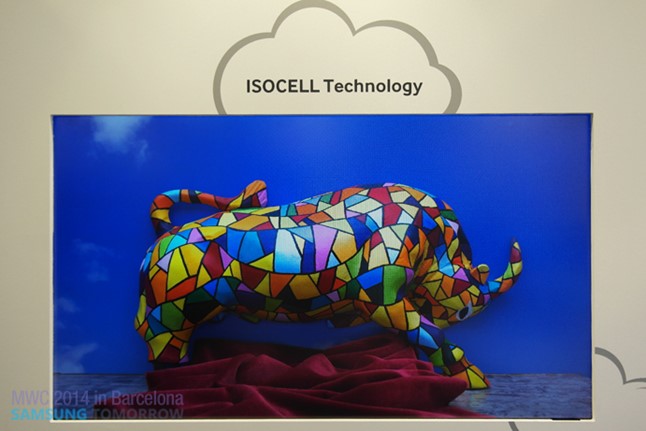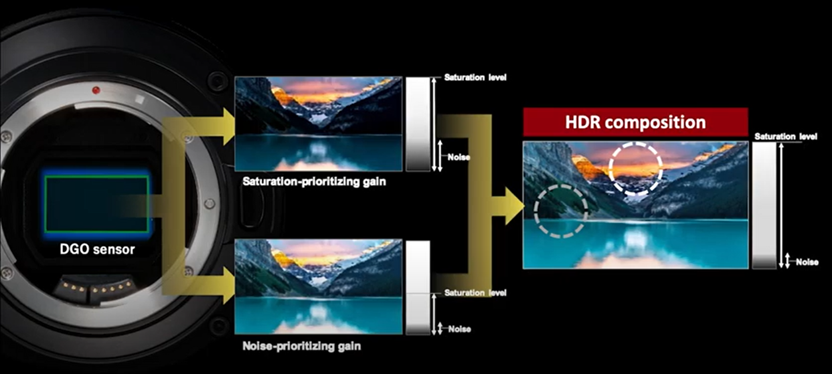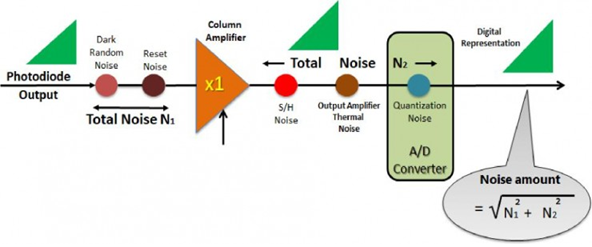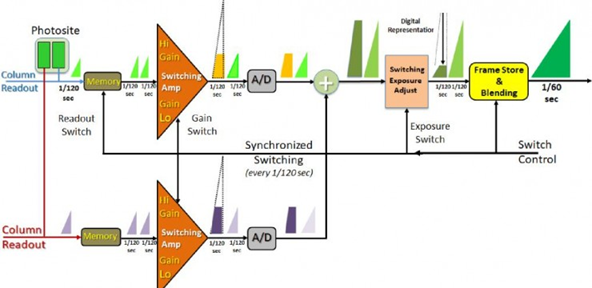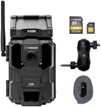The security cameras with built-in SIM card slot are usually referred to as SIM cameras, cellular security cameras, LTE security cameras, or 4G security cameras. Inside these cameras, a slot is available to insert a SIM card.
They work on the 4G/3G phone network for wireless transmission of image and video signals. As a result, you can see real-time videos of any place without power and Wi-Fi on your phone (which can also transmit on Cloud storage facilities) from anywhere.
When it comes to their operations, they operate by connecting to a cellular phone network through a SIM card. The inserted SIM cards connect the camera to the Internet through the cellular networks of Verizon, AT&T, and Sprint.
Note that the SIM card will not permit your camera to connect to a standard Wi-Fi network in your home or office. The reason is it doesn’t contain a Wi-Fi adapter. So, it’s not like your smartphone because it includes both a Wi-Fi adapter and a SIM card.
Now let’s check out some related FAQs:
FAQs:
1. How can you choose a data plan for a security camera with a SIM card slot?
Firstly, you need to choose a mobile service provider that can work with your SIM card security cameras in the area to be monitored. Make sure phone signals are powerful there. The next step is to contact the cellular service supplier about the data plans and then select the one that best suits your security needs.
2. What are the batteries recommended for security cameras with SIM card slots?
For these cameras, it is recommended to use rechargeable lithium batteries. Lithium batteries can operate in extreme weather conditions, whereas alkaline batteries can’t. Moreover, with the inclusion of rechargeable lithium batteries, the lifespan of these cameras improves.
3. Do security cameras with SIM card slots consume your cellular data?
Yes, these cameras will consume the cellular data in the below circumstances:
- The SIM card security camera systems deliver alerts when motion is detected and then upload videos to the cloud.
- You access your 3G/4G SIM card surveillance camera to live view remotely.
- The SIM card security camera has poor mobile signals, and so you need to retry repeatedly.
- When you launch your SIM card security camera app, a small amount of data will be consumed.
4. What are the steps to set up a security camera with a SIM card slot?
- Check whether the camera has a pre-installed SIM card or not
- Carefully insert the SIM card and battery
- Decide whether you have to record videos locally
- Place the camera in cellular network coverage
- Download the SIM card security camera app and add your device to the App.
5. How much data does a security camera with a SIM card slot
consume?
It depends on how long the camera is operational and the settings in your camera.
For example, if your camera is streaming extremely high-quality videos to your phone (approx. 1.5 Mbps), it will consume approximately—1 G.B. of data per hour of footage. But, if you set your camera to stream lower quality images (like 200 kbps), then 1 G.B. of data will last for approx. 10 hours.
From Amazon Global:
16. Yellowstone.ai 4G LTE Trail Camera:

Check on Amazon
This wireless cellular trail camera can send photos and videos on any phone (AT&T, Verizon, T-Mobile, Sprint, and more). The built-in sensor detects motion and triggers a picture after 0.4 seconds. Subsequently, the camera sends that picture to you. Usually, this process takes a minute.
You can receive your pictures on any Internet-connected computer, phone, or tablet, irrespective of your wireless provider. Moreover, you can manage camera settings, share/receive photographs, supervise camera health, administer data plans, and set up phone/email alerts through your website and App.
Irrespective of your cellphone provider, this camera sends images to anybody. The high-gain antennas deliver enhanced coverage than the majority of other phones. You can pause or cancel your data plan anytime.
Once you complete the setup, you will receive the first image on your phone in approx. 4 minutes. Preconfigured SD card and SIM card are included for easy, quick setup. So, you can manage your camera and data plans anywhere.
Easy-to-follow instructions and a quick-start guide are included in the pack.
Features:
- This camera, data plan, and SIM card are pre-configured to work on AT&T and T-Mobile towers simultaneously.
- The plans vary from $6.00+ to $44.99/month per camera without any long-term contracts.
- The video resolution is 1080p full H.D., and the picture resolution is 12 M.P.
- For regions with limited cell coverage, the manufacturer provides the flexibility to send pictures to your phone and save videos locally on this camera.
- The camera body is IP66 waterproof & dustproof. It can operate in low temperatures up to -13° F.
- The battery life is usually 2-20 weeks, based on settings, activity, and temperature.
- This camera can send videos to your phone, but only if it possesses a potent 4G connection.
- Passive infrared motion detection technology is used to use energy efficiently.
- Additional features: GPS, 57-piece 940 nm no-glow invisible night vision, multi-shot burst, customizable hours of operation for pictures (only specific times of day), time-lapse, ~65′ motion-detection range (differs by size of the motion and temperature), instant images & videos, bright LCD screen, and custom integration into your website.
15. Spartan 4G LTE GoCam:

Check on Amazon | Check on Newegg
Spartan GoCam is a wireless trail camera with a mount. It comes with a SIM card and is ready to use out of the box. You just need to buy service from Spartan, adjust your anticipated picture parameters, and finally, the camera is ready to use. Spartan built it in a water-resistant and dust-tight IP65-rating construction. So, it can resist most weather elements.
The easy-to-use and intuitive App developed for Spartan is accessible on both Android and iOS platforms. So, you can easily and quickly view the output on mobile. All the setup menus are easy-to-use and understandable.
Though a setup program can be operated on your computer, all functions/features/settings are available through the camera’s menus. Mounting is easy with the help of an included mounting strap, tripod, and Python lock.
Features:
- Video transmission technology is implemented, and Rapid image transmission is supported.
- Photo Burst is 1, 2, 3.
- Trigger time is 0.6s.
- The image capture speed is 30 fps.
- The size of the LCD is 2 inches.
- The Flash range is 80 feet.
- The field of view is 52°.
- 3 PIR sensitivity options are included.
- The maximum photo resolution you can set is 8 M.P.
- The modes contain motion PIR with adjustable settings.
- Time-lapse has 3 interval options: 5-second to 1-minute, 1-minute to 60-minute, and 1-hour to 8-hour.
- Shooting modes are Night and Time-Lapse.
- You can capture up to 30-second long video clips, including sound.
- The blackout flash invisible IR LED array delivers illumination up to 80 feet for clear, crisp images/videos at night.
- The information strip present on photos shows time, date, temperature, moon phase, and battery level.
- Up to 32 GB SD card is supported. (S.D. The card slot is available on the left; it has a big cutout allowing you to insert or remove the S.D. card easily.)
- This camera can be powered by 4V/ 8V/ 12V A.A. batteries. An option to use a 6V external power supply is available.
- For ease of operation, an ON/SETUP/OFF switch and well-marked buttons are included.
- A USB port and external 6V D.C., power supply ports are available on the bottom.
- Besides the App, a web portal is available, which can be accessed from the browser of any computer. Whether you use an app or web portal, you benefit from remote camera management.
14. ROMIX 1080P Outdoor Wireless Bullet Security I.P. Camera:
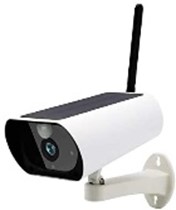
Check on Amazon
This solar/battery-powered security I.P. camera is equipped with a 4G LTE SIM card. You can use either power it with two 3.7V 18650 mAh rechargeable Lithium batteries or a solar panel. It is entirely wire-free to set up in tunnels, highways, orchards, Glasslands, railway crossings, and farms. The camera comes as a 4G frequency customized.
Other accessories included in the box are a camera bracket, installation tools, a USB charging line, and a user manual.
Features:
- FHD 1080P COMS sensor is included.
- The video resolution options are: 1920*1080p@ 15 fps, 640*360p @ 30 fps.
- Sensor modes are A.E., AWB, Automatic backlight compensation, and Digital wide Dynamic.
- Photosensitive automatic switch Day/Night mode is included.
- 850 nm I.R. radiation for Night Vision works up to 10 m.
- The Hisilicon Hi1131 (low power consumption) Wi-Fi module is included for Wi-Fi connectivity.
2G2P H.D. lens comes with a 2.8 field of view and 120° wide viewing angle. - The battery life is approx. 10 days without sunshine.
- USB charging lasts for approx. 6 hours.
- Active mode: 15S/30S/60S/Always
- Wi-Fi configuration is Q.R. code scanning.
- Audio decode protocols implemented are AAC and G.726.
- The microphone sensitivity is -38 dB.
- The video compression format is H264.
- Implemented network protocols are HTTP, TCP/IP, TCP, UDP, DHCP, SMTP, P2P, and DNS.
- The temperature range is -10℃ ~+50℃.
- For status indication, Blue and Red LEDs are included.
- The capacity of the T.F. card can support 4 G.B. – 64 G.B.
- Video playback includes Timeline and Cloud Storage (7 days loop recording supported).
- The camera body is IP67 waterproof.
- The phone system requests support for Android 5.0 and iOS 10.0.
- Other features are a Full-duplex intercom, Events Alert support, and Reset/Power key.
- With 4G LTE connectivity, there is almost zero data consumption when the camera sleeps (2 M.B./day). For video watching, 150 MB/hour of data is consumed.
- Two-way Audio helps keep an eye on kids, pets, and old-age people. It also helps in monitoring the entrance of any building remotely.
- With included speakers and a microphone, you can monitor users by mobile phone app. Also, you benefit from a real-time remote video voice intercom.
- The PIR Motion Detection feature automatically wakes up the camera when any object or person passes across. So, the camera sends an alert to the phone.
13. SPYPOINT LINK-S Solar Cellular Trail Camera:
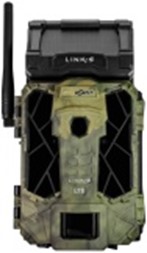
Check on Amazon
This cellular trail camera is activated and configured through the SPYPOINT LINK APP with Buck Tracker (an A.I. solution) that connects with leading U.S. cellular providers. A rechargeable battery and patented solar panel are built inside.
Both of them provide infinite battery life within reach. Also, they save hundreds of dollars otherwise spent on batteries. The invisible LEDs provide the fastest trigger on the market.
This camera is well-known for its speed, efficient solar energy output, and remarkable night pictures. Fewer trips save time and gas. Its operation doesn’t damage the environment.
The photo transmission plans of SPYPOINT are the simplest to understand. These plans are the most affordable ones.
Package content includes this camera, a USB-12V cable, a mounting bracket, a SIM card, a strap, and a quick-start guide.
Features:
- The photo resolution is 12 M.P.
- The Flash range is 100 feet, and the Detection range is 100 feet.
- The trigger speed of 0.07 seconds implies fewer images with a game already out of the frame.
- Supported mods are PHOTO, TIME-LAPSE, MULTI-SHOT, and HD VIDEO.
- Advanced technologies and features implemented: 4G/LTE cellular connectivity, SPYPOINT LINK APP with Buck Tracker (an A.I. solution), Infrared Boost, 42 LEDs, Blur Reduction, 6 multi-shots, curved motion sensor lens, Blur Reduction & I.R. Boost, and H.D. video + sound.
- Up to 32 G.B. memory cards can be inserted.
- SPYPOINT App receives Full HD images. No need to open the camera to recover your card. Hence, you can see exactly what is waiting in the shadows.
- The screen size is 2 inches.
12. Wireless Security Camera Outdoor with Cellular 4G Network:
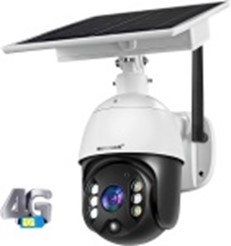
Check on Amazon
Use a rechargeable battery or solar panel to power this wireless security camera. It is wire-free and is connected to the Internet via 4G LTE. It is compatible with T-Mobile and AT&T 4G/LTE data SIM cards. When using the 4G/LTE data SIM card, ascertain that the SIM card comes with data plans and phone numbers together.
The 8W solar panel and built-in high-capacity rechargeable Li-ion battery remove worries about battery life. The solar panel can charge even in low light. A tool bag, a bracket paper for installation, and a user manual are included in the pack.
Simply download the UBox APP and register an account. Now turn on the security camera, scan the Q.R. code in the App, and complete the initial setup. Finally, after connecting, you can live to view it, alter the setting or set it to any angle from the App.
Features:
- 3G/4G frequency bands supported: America Version: LTE FDD: B2/B4/B12, WCDMA: B2/B4/B5.
- The 2 M.P. camera and 1/2″ image sensor allow you to capture and record sharp and clear images day and night.
- The image resolution is 1080P H.D. with full coverage in any corner.
- 4 floodlight LEDs and 2 Infrared LEDs offer clear, Colorful Night Vision.
- Digital Zoom capability is 3X.
- You can rotate the camera 90° vertically and 320° horizontally to encompass all angles of the garden or house.
- PIR Motion Detection and Radar Detection work up to 40 feet. They work collectively to record all security events. You will receive intelligent alerts, and wrong detections will be reduced.
- The camera body is IP65 weather-resistant between -4℉ to 140℉.
- 10400 mAh battery is implemented with the Smart Power Saving System.
- The camera can record videos to the cloud (30 days free trial) and an S.D. card. When motion is triggered, an alarm is sent to your phone. Real-time viewing and playback happen in the Android/iOS App.
- Other features are 2-way audio and Sound and Light Alarms.
- The local T.F. card slot allows you to insert an 8 G.B. to 64 GB SD card.
11. WingHome 4G Cellular Trail Camera 480Ace:
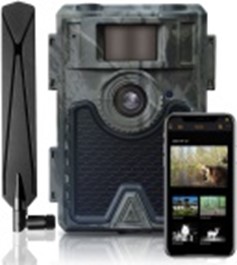
Check on Amazon
This WingHome trail camera operates on 4G LTE data transmission. The exceptional attribute of this trail cam is that it smartly adjusts its light according to daylight. In the daytime, it generates colorful images; in the night-time, it generates black/white photos.
After the camera triggers, videos or photos are directly delivered to your Mobile APP anytime, anywhere. So, it significantly saves you time to retrieve S.D. cards. Hence, you can focus on other essential tasks. It is easy to modify camera settings from APP and allow it to synchronize even from hundreds of miles away.
WingHome Trail Cam APP is available for download from Google Play Store or App Store. You can scan the Q.R. code to activate the camera. You simply need to choose your desired data plan to activate the SIM card. After 1 minute, you can begin using the camera.
Features:
- The video resolution is FHD, and the camera resolution options are 8/12/24 M.P.
- Advanced NO-GLOW technology is implemented.
- To let you confidentially observe wildlife, traps, and feeders, 60 pieces of 940 nm-IR LEDs are included.
- With the 0.4s trigger speed, capturing animal movements occurs at lightning speed.
- The motion detection range is up to 20 meters.
- 100° wide-angle lets you capture whatever is in front of the camera in high-quality detail.
- The camera body is IP66 waterproof, resisting all outdoor weather elements, including heavy rain and snow.
- The temperature range is -25°C to 60°C.
- It is flexible to adapt the WingHome hunting camera settings according to the swiftly changing game conditions. You can choose your winning settings from Night Mode, Camera Mode, PIR sensitivity, Time Lapse, Multi-shot, and Flash Power.
10. 3G/4G LTE Solar-Powered Cellular Security Camera System:
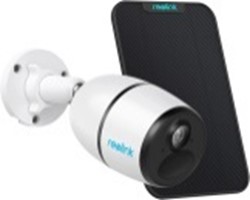
Check on Amazon
For hiking, boating, and other outdoor recreations, it is recommended to use this security camera system. You can set it up in living rooms, kitchens, hallways, and garages. When used as a solar-powered security camera with a wireless connection, it works well in areas with weak or no Wi-Fi access or electrical power sources. Hence, it can be set up in hotels, trailers, campers, R.V.s, workplaces, construction sites, farms, ranches, warehouses, etc.
It supports 4G-LTE and 3G GSM network connectivity. The constant solar power supply from Solar Panel lets you realize complete wire-free security. Three of the most admirable aspects of this camera are the high-capacity battery, long-lasting power per charge, and IP65 weatherproof. Being weatherproof and portable, you can install or carry Reolink Go anywhere.
In addition to providing security, this camera lets you talk and listen with other people and ward off prospective burglars when off-site. You can live view and playback from your computers or phones.
Simply mount the camera and insert the battery, S.D. card, and SIM card. Finally, you need to scan the Q.R. code with the App.
Detailed steps to set up this security camera:
- Firstly, insert the Nano-SIM (externally) into the SIM card slot and wait for the LED status to convert to blue.
- Now download Reolink APP or P.C. Client. (You can check the instruction of the quick-start guide (available in the box).
- Scan the Q.R. code on the bottom of this camera via the Reolink APP/PC Client.
- Finally, follow the instruction on the Reolink APP/PC Client to complete the setup.
Note: This camera only works with a 3G/4G cellular network. It can’t work with a Wi-Fi connection. It doesn’t support other carriers like Verizon.
Features:
- With Full HD resolution and a 110° wide field of vision, this camera can capture sharp, crystal-clear videos.
- With the built-in Starlight CMOS image sensor, you can view clear Night Vision up to 33 feet and colorful images in dim light.
- Reolink Go can automatically record video to Reolink Cloud and micro S.D. card when motion is detected. You can review the Cloud video of the last 7 days for free.
- By adjusting a sensitive digital smart PIR sensor, all potential dangers approaching your home will be accurately identified. Subsequently, alerts will be instantly delivered to your phone.
- You can manage multiple devices and share with max. 10 persons to live view simultaneously.
- A trigger speed of 0.8-second can rapidly wake up and lets you catch any movements with fewer false alarms.
- The detection sensitivity is customizable and can be scheduled from the Free Reolink Mobile App and Client.
9. VOSKER V150 LTE Cellular Security Camera:
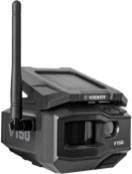
Check on Amazon
Now you can supervise any remote locations where a cellular signal is available with this wire-free outdoor security camera. It utilizes 4G/LTE cellular network connectivity; no Wi-Fi. A pre-activated SIM card is included. A micro S.D. card is included for local backups.
This camera guarantees extended battery life and peace of mind with the long-lasting rechargeable battery pack and solar panel. The motion-activated photo surveillance begins working when there is no Wi-Fi network access or any source of electricity. So, this security camera works well on ranches, farms, construction sites, cabins, parking lots, and vacation homes.
The adjustable mounting arm simplifies the installation. Simply set it up and let it work anywhere. The easy and quick setup connects this camera to your VOSKER account. Hence, you can receive photos on your phone and begin inspecting your property in a few minutes.
Accessories packed in are a 10,000 mAh Lithium battery (V-LIT-B2), amounting arm, a 3 feet USB charging cable, a quick-start guide, a SIM card, a 16 G.B. micro S.D. card, and a Window Sticker “Protected by Vosker.”
Features:
- VOSKER SENSE AI Image Recognition recognizes security threats or potential threats with simple filtering options. It instant sends notifications to Vosker app (Android and iOS) whenever activity is detected within up to 90 feet of detection range. So, it becomes easier for the camera to focus on the security of your target location.
- Photos are captured whenever the motion-activated sensor is triggered and delivered to your mobile App.
- Night Vision range: <80 feet.
- The camera body is IP65 weather-resistant.
- The form factor is bullet.
- The hybrid Time Lapse and Movement Detection mode are included.
8. Vosker V200 Cellular Security Camera:
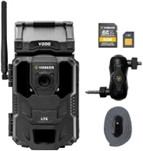
Check on Amazon | Check on Newegg
Vosker V200 comes with a pre-activated nationwide SIM card and a wide range of mobile security plans (including free). With the setup of this camera, you can supervise a job site, cabin, farm, country home, or any other remote location. This camera incorporates the design of a trail cam and the functionalities of a surveillance camera.
It uses ultra-fast 4G/LTE connectivity, solar charging, and an app like a cell phone—no need for Wi-Fi. Apart from using solar power for charging, it can also operate on a rechargeable battery pack or 8 A.A. batteries or a 12V battery—no need for Wi-Fi or wired connections for transmission of photos on smartphone LTE connectivity.
Due to its rugged and weather-resistant design, it can work in all environments. The onboard recording is possible with the included S.D. card slot for local backup.
List of included accessories: pre-activated SIM card, mounting bracket, strap, S.D. card, charging cable, and a quick-start guide.
Features:
- With the H.D. camera, which captures photography in high-quality detail, you can protect your region with the A.I. recognition technology.
- A.I. Image Recognition helps you recognize vehicles/people or monitor areas with advanced analysis. You will receive only the photos you require.
- Advanced A.I. image detection works up to 100 feet.
- Hybrid Time Lapse + movement detection mode are included.
- Automatic motion detection and Night Vision technology are implemented.
7. Verizon V100 4G Mobile Security Camera:
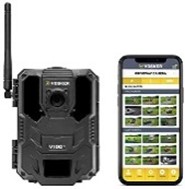
Check on Amazon
Verizon V100 comes with a pre-activated Verizon SIM card. This camera is suitable for offices, living rooms, bedrooms, bathrooms, kitchens, hallways, study rooms, construction sites, country houses, farms, vacation homes, cabins, and other remote locations.
It is designed to convey 24/7 photo coverage you can rely upon. Also, it provides you the access you require while you’re on the go. Therefore, this camera connects wirelessly to your smartphone and sends data and photos via the VOSKER app (Android and iOS). No need for Wi-Fi.
You can directly receive custom alerts and notifications on your smartphone. You can also change the camera settings and obtain live support if you need it. So, it provides you with better peace of mind, control, and the capability to monitor your space day or night.
Features:
- Ultra-fast 4G Connectivity (No Wi-Fi) is implemented.
- Z-Wave connectivity protocol is implemented.
- Advanced A.I. image detection works up to 100 feet.
- A Built-In SD card slot is available for local backup
- The rugged, weather-resistant design allows you to use it in different outdoor environments.
- The video resolution is 1920 x 1080p on the S.D. card and 600 x 338 on the mobile App.
- Photo first option captures a still picture first before beginning the video recording.
- A solar panel is built inside.
- Time-lapse mode is available.
6. Arlo Go Mobile H.D. Security Camera:
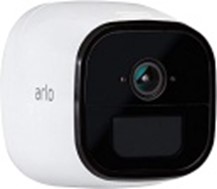
Check on Amazon
Arlo Go is a perfect choice for living rooms, bedrooms, kitchens, classrooms, study rooms, and hallways. It comes with a data plan and works anywhere nationwide. It has Alexa compatibility for voice control. Being 100% wire-free and IP65 weather-resistant, you can discreetly place cameras indoors and outdoors. This camera supports 3G and 4G-LTE wireless connections to provide untethered mobile security.
Features:
- 850 nm LEDs support Night Vision and illuminate up to 25 feet. The enhanced Night Vision lets you clearly see in the dark.
- The viewing angle of the lens is up to 130°.
- A wide-angle PIR motion sensor guarantees that no movement will get unnoticed.
- Two-way audio lets you listen and talk back via the built-in microphone and speaker directly from your smartphone.
- Cloud recording is allowed free for 7 days.
- This camera is compatible with Google Assistant, Amazon Alexa, IFTTT, and Stringify.
- With powerful Intelligence, you can customize alerts to detect specific zones and people and contact emergency responders directly from your smartphone’s lock screen.
- The included S.D. card slot allows local audio and video backup storage during Internet interruption.
5. CREATIVE XP Cellular Trail Camera:

Check on Amazon
This cellular trail camera is suitable for security, hunting, construction, farm surveillance, night-time wildlife photography, and wildlife monitoring. The entire operation stays confidential.
A 32 GB SD card and a 4G LTE PLUS Cellular Simhero card are included. The mentioned SIM card is compatible with AT&T or T-Mobile (Rogers for C.A.). It can store 500 free photos.
Irrespective of the location, this camera works flawlessly. Its body is windproof, waterproof, and snowproof.
The activation is relatively easy; simply insert the activated SIM card and buy the affordable data plan. Add U.S. phone or email. Finally, wait for something to trigger the motion sensor.
In addition to batteries and the solar panel, the pack includes accessories like LTE antennas, a 32 G.B. micro S.D. card, a SIM card, a tree strap, and a tree mount.
Features:
- You can decide how to charge it, i.e., either battery/solar powered. 12 A.A. batteries are included, and the camera is compatible with the CREATIVE XP solar panel (9-12V, 2400 mAh).
- This camera can be powered with batteries/ solar panel/ an A.C. outlet/external battery.
- To provide 1080p video and crystal-clear photos at the output, this trail camera uses Infrared technology with a 65 feet range.
- This camera can record 12 M.P. photos and 10 ADP videos day or night with Night Vision technology.
- The time-lapse feature helps even more in capturing quality photos.
- The quick 0.35-second trigger and wide-angle 110° PIR lens help you obtain 1-5 photos/videos in every trigger shot.
- The cellular feature lets you instantly send pictures and videos which are captured on any U.S. phone by email
- 56 I.R. LEDs are included, and they are virtually invisible to wildlife.
- This camera is Alexa-compatible.
4. Reolink Cellular Security Camera, Go Plus:
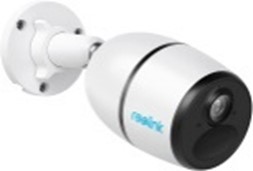
Check on Amazon
Whether it’s a bedroom or living room or storeroom or yard, or any outdoor place, you can ensure your security and the place with this camera. It supports 3G and 4G LTE networks.
Hence, you can insert a 4G LTE SIM card and install it anywhere. With access to solar-powered and detachable battery (can work for 2-6 months) options, there are no worries of running out of juice.
With the help of this camera, you can capture activity (which can be as long as hours, days or weeks) and then observe the dynamic long-term process in minutes or seconds.
You can power up this security camera with a rechargeable battery, a Reolink Solar Panel (not included) or a 5V/2A USB power adaptor.
Features:
- 3G/4G frequency bands supported: America Version: LTE FDD: B2/B4/B12, WCDMA: B2/B4/B5.
- A 1/3″ CMOS sensor is included.
- With 2560 x 1440 (4MP) resolution @ 15 fps, this security camera captures clear, sharp footage for more visual details.
- The supported video format is H.265.
- The fixed lens field of view is 95° horizontal and 52° vertical.
- 16x digital zoom is supported.
- PIR Detecting Distance is adjustable up to 10 m.
- PIR Detecting angle is 120° horizontal.
- The infrared LEDs offer superior image quality for night-time recording. It supports up to 10 m (33 feet) of Night Vision.
- With intelligent person/vehicle detection and advanced detection algorithm, this surveillance camera recognizes real threats to decrease false alerts. The siren will be activated whenever anything suspicious is detected, and the camera sends you an email and instant push notification.
- The camera automatically records videos to a micro S.D. card (up to 128 GB) and the Reolink Cloud whenever motion is detected.
- Your Cloud video history is accessible through Reolink App or web page. Also, you can get a 7-day free cloud video history on Reolink Cloud.
- Unique detection modes can filter videos to replay the one you prefer.
- Reolink Go Plus can be accessed anywhere and anytime to check events happening. So, you can share with friends or family to live view simultaneously.
- Live view is allowed for up to 12 persons at once.
- Two-way talk is supported.
- You can remotely talk with people via the free Reolink App and Client with a built-in mic and speaker.
- Time-Lapse shows vivid movements.
- Types of alerts supported: push notifications, Instant email alerts, siren, and customized verbal alerts.
- The camera body is IP65 weatherproof.
- The temperature range is 14° to 131° F.
3. Reolink Go P.T. (U.S. Version):
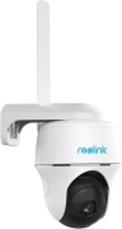
Check on Amazon | Check on Newegg
Reolink Go P.T. offers untethered mobile security. It can work throughout the nation with the 4G/LTE coverage. Its operation is 100% wire-free; no Wi-Fi is needed. It can be used outdoors like backyard, front door, garden, driveway, porch, etc. The solar power support can generate power even during rainy or Cloudy days.
T-Mobile U.S. network operator is compatible with this camera (recommended to use Prepaid Data Plan). This 4G security camera can work independently with a long-lasting rechargeable battery, irrespective of an unexpected blackout.
List of included accessories: 32 G.B. micro S.D. card, an antenna, a camera bracket, a mounting hole template, a surveillance sign, a reset needle, a quick-start guide, a pack of screws, and a micro USB cable.
Features:
- 3G/4G frequency bands supported: America Version: LTE FDD: B2/B4/B12, WCDMA: B2/B4/B5.
- Starlight CMOS image sensor is included.
- Video resolution is 1080p HD @ 15 fps.
- PIR detecting angle is 90° horizontal.
- PIR detecting distance is adjustable up to 10 m.
- Night Vision works up to 10 m.
- The field of view of the fixed lens is 105° diagonal.
- 6x Digital Zoom is included.
- Siren Alert includes Customized Verbal Alerts.
- Other alerts are Instant Email Alerts and Push Notifications.
- For broad range area monitoring, this camera can rotate 140° vertically and 355° horizontally.
- The ability to tilt up and down, and pan left and right, allows this camera to provide comprehensive coverage without blind spots.
- The pan-tilt feature can be remotely controlled through Reolink App.
- The wide-angle PIR motion sensor allows advanced motion detection. It guarantees that no movement will go unnoticed. Once an event is captured, you will be promptly alerted.
- You can hear and talk back via the 2-way talk and built-in mic & speaker from your smartphone.
- The camera body is IP64 Weatherproof, and the waterproof casing can survive harsh weather conditions.
- 8 people can simultaneously stream videos with 2 users allowed to view mainstream videos on their phones.
- Nano-SIM (4FF) SIM card (0.48×0.35×0.026 inch) is supported (not included).
2. Reolink Go PT w/ Solar Panel:
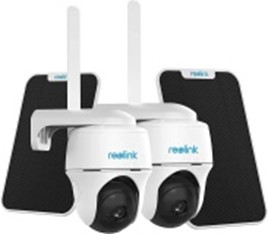
Check on Amazon
The bundle includes two Reolink Go P.T. cameras with solar panels. It is an entirely wire-free outdoor surveillance camera that operates on 3G and 4G LTE networks. Its operation doesn’t need Wi-Fi, and no wiring hassles are involved.
With the support for an ultra-wide viewing angle of 140° tilt and355° pan, it can serve as a perfect security solution for huge areas like forests, warehouses, etc. It comes in a waterproof casing to survive harsh weather conditions.
Unlike trail cameras, this intelligent security camera permits you to have real-time control. So, it is a huge plus. You can supervise the progress of jobs or what’s happening around your property without being physically there.
This security camera would wake up and record a video clip for playback purposes whenever motion is detected. Note that the motion events will get saved in a micro S.D. card or the Reolink Cloud. You can view history videos anytime. With a tap, you can hear and speak to friends or family.
Features:
- The built-in starlight CMOS sensor assists you in shooting decent-quality images even in darkness.
- The encrypted Cloud service offers off-site backup and lets you playback and access video history anywhere.
- You can remotely access Reolink Go P.T. to receive live streaming.
- You can stay updated on your business and home through free Reolink software on Android/iOS phones or Mac/Windows computers.
- In addition to the push notifications, this camera also creates sirens or customized voice alerts to frighten off burglars.
- With built-in 2-way talk, you can confront thieves and ensure security.
- Motion masking and Privacy masking protect your privacy and prevent unwanted alarms or recordings.
- Supported SIM card format is Nano-SIM (4FF) (0.48×0.35×0.026 inch) (not included).
- This camera supports T-Mobile U.S. Network Operator (prepaid data plan recommended)
- 16 G.B. Micro SD card is included.
1. Reolink 3G/4G LTE Cellular Security Camera:
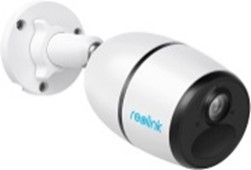
Check on Amazon | Check on Newegg
You can power this Reolink security camera with a rechargeable battery or solar power. It can be charged through a universal 5V/2A phone adapter and the Reolink solar panel for continuous power. This weatherproof security camera can run without Internet access. It can be used in offices, hotels, campers, R.V.s, trailers, farms, warehouses, stables, etc.
One of its superlative aspects is that you can live to view the surveillance camera with 12 people simultaneously. The setup is accessible via the Reolink App by following the voice instructions.
SIM Card Format: Nano-SIM (4FF) 0.48 x 0.35 x 0.026 inch
Note: Before using this camera, you require a nano-SIM card and cellular data plan. This camera only works with a 4G/3G cellular network; it doesn’t work with a Wi-Fi connection. It doesn’t support other carriers like Verizon.
Features:
- The Full HD resolution and the 110° wide field of vision make sure this camera can encompass broad areas and decrease blind spots.
- The Night Vision works up to 33 feet.
- With the latest 2 M.P. starlight CMOS image sensor, this camera will cover all the details during the day and night.
- Features related to motion detection are Smart Motion Detect, Instant PIR Motion Alerts, motion recording, PIR schedule and sensitivity adjustment, email alerts, push notifications, customized voice alerts, and sound alarms.
- The PIR (Passive Infrared) sensor gets infrared radiation as heat from the surrounding. When the monitor’s movement occurs, it rapidly wakes up in 0.8s and provides you with real-time alerts.
- The PIR detecting distance is up to 10 m.
- Being IP65 weatherproof and supporting solar charging, you can install or carry this camera anywhere.
- It is allowed to remotely access this dome I.P. camera to obtain live streaming and be aware of your office and home via the free Reolink App.
- Noise reduction technology filters noises in the background and provides clear audio.
- The siren (75 dB) or customized voice alert sounds automatic to frighten the burglars.
- Two-way audio is crystal-clear.
Steps to set up this camera:
- Insert the Nano-SIM (external) into the SIM card slot of the camera.
- Wait for the LED status to turn blue.
- Download Reolink APP or P.C. Client and follow the instruction of the quick-start guide (available in the pack).
- In this step, you have to use the Reolink APP/PC Client to scan the Q.R. code at the bottom of the camera.
- Follow the instruction given on the Reolink APP/PC Client to complete the setup.
Concluding Note:
Wireless transmission of image and video signals flawlessly with the 4G/3G phone network support in these security cameras. They provide fast connection speed and a clear live view of the area under detection.
